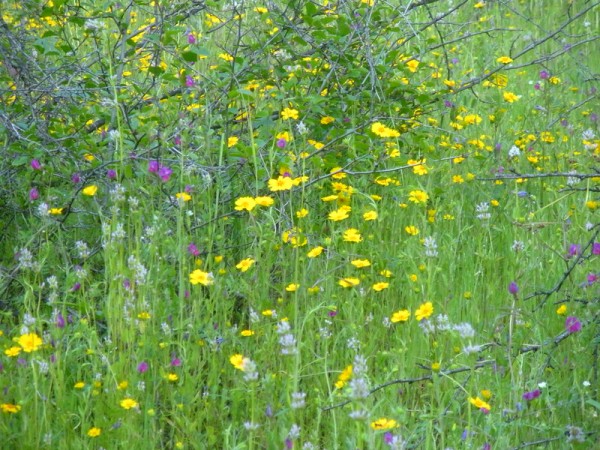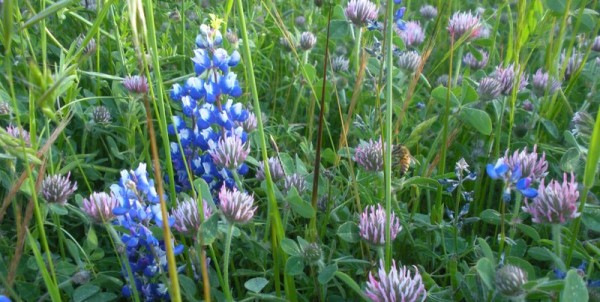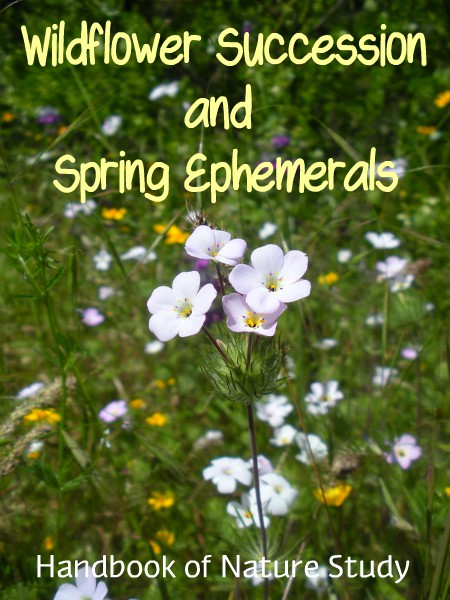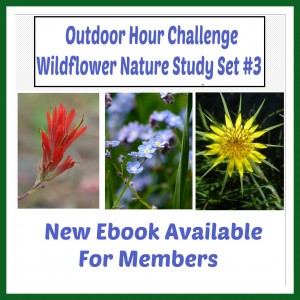Wildflower Succession and Ephemerals
Wildflowers take their “turns” as they bloom through each season. This idea came to me years ago as I hiked the same trail many times a month and I noted that a certain meadow always had a flower blooming. The wildflowers don’t all bloom at the same time but they do bloom in the same order each year. This “cycle” or succession of flowers gives us a way to mark time.
 In the early spring, the meadow comes alive with popcorn flower. Next to bloom are the shooting stars, the California poppies, and the purple Chinese houses. Making observations of the meadow has become an annual activity for me and it is enjoyable to know which flowers to anticipate as the season goes on. The early spring wildflowers make their appearance before the surrounding trees leaf out and make shade. These plants quickly flower and go to seed, waiting for the next year to bloom again.
In the early spring, the meadow comes alive with popcorn flower. Next to bloom are the shooting stars, the California poppies, and the purple Chinese houses. Making observations of the meadow has become an annual activity for me and it is enjoyable to know which flowers to anticipate as the season goes on. The early spring wildflowers make their appearance before the surrounding trees leaf out and make shade. These plants quickly flower and go to seed, waiting for the next year to bloom again.
This cycle of flowering and then seed dropping fascinates me. I imagine all those seeds layered there in the soil just waiting for the conditions to be right in order for them to start their blooming cycle again the next year.

Spring ephemerals: Ephemeral means short lived or lasting for a brief time. In the case of wildflowers, these are usually the first flowers to develop stems, leaves, and flowers. They spring up quickly, bloom, seed, and then disappear once the temperatures heat up and the trees grow overhead. They don’t really die but go dormant.
Here are some from my Sierra Foothill habitat in California:
¨ Blue Dicks, Dichelostemma capitatum
¨ California Golden Violet, Viola pedunculata
¨ Elegant Brodiaea, Brodiaea elegans
¨ Hooker’s Evening Primrose, Oenothera elata hookeri
¨ Mariposa or Butterfly Lily, Calochortus venustus
¨ Miner’s lettuce, Claytonia perfoliata
¨ Miniature lupine, Lupinus bicolor
¨ Owl’s Clover or Valley Tassels, Castilleja lineariloba
¨ Pretty Face, Triteleia ixioides
¨ Rose Globe or Fairy Lily, Calochortus amoenus
¨ Shooting Star, Dodecatheon jeffreyi
What are the spring ephemeral wildflowers in your area?
Activity
Wildflower Succession in Your Neighborhood
Choose a wildflower that grows in your neighborhood to watch each spring. Create a long term record of its initial bloom time each year. Use the data and compare the dates from year to year. Did weather– rainfall, snowfall, temperature– affect its blooming?
Wildflower Related Citizen Science Project Opportunity
Join Nature’s Notebook and make observations of a specific plant (or animal) in your area. By submitting data to this program, you will be helping scientists in their research. See the website for details and instructions. Click here for more information: Nature’s Notebook.
This article first appeared in the April 2016 Handbook of Nature Study Newsletter.
You may wish to download one of the wildflower ebooks from your Ultimate Naturalist Library and use it this spring and summer for your nature study time.
Here is a list of the wildflowers included in those ebooks:
Ebook #1: Field mustard, Wild radish, Shooting star, Lupine, Purple Chinese houses, Yarrow.
Eboook #2: Henbit, Cow parsnip, Columbine, Chicory, Cocklebur.
Ebook #3: Fireweed, Salsify, Forget-Me-Not, Paintbrush, Common silverweed.

You can also find many more wildflower nature study challenges on the Wildflower tab on the website.






